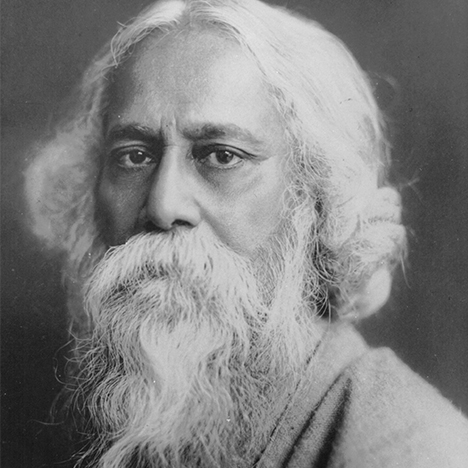


If you visited the Rubin’s 2018 exhibition A Lost Future: The Otolith Group, you learned about one part of the vast legacy of Rabindranath Tagore, who founded the Visva Bharati art school that’s featured in The Otolith Groups work. But do you know why he’s such a beloved and influential figure in India? Though his name might be familiar (along with a few terms that circle around him, like “polymath” and “Nobel Laureate”) many in the West are not acquainted with his major contributions to world literature, philosophy, and education.
Tagore was born in 1861 in Calcutta to an aristocratic family that treasured learning and embraced ideas from both the East and West. His paternal grandfather paid visits to Queen Victoria, and other members of the clan studied at Oxford and the Royal Academy. Tagore’s father was one of the founders of the Adi Dharm faith, a monotheistic religion that drew on Hindu traditions but opposed the caste system and rejected the authority of scripture. Their cosmopolitan outlook helped place the Tagore family at the vanguard of the Swadeshi movement, which included politicians, social reformers, and artists opposed to British rule.
In this rich environment, Tagore’s insatiable intellect took root and flourished. He was educated by private teachers at home during his childhood, and later by his father, who tutored him in astronomy, Sanskrit, and history. At age 17 he began attending a public school in England, where his family owned property, and later he studied law at University College London, but he never finished his degree, preferring to study independently.
—I have to found a world center for the study of humanity there. The days of petty nationalism are numbered … I want to make that place somewhere beyond the limits of nation and geography.
Rabindranath Tagore
Tagore’s literary talents emerged early. As an eight-year-old he was already writing poetry, and he released his first serious verse at 16, under the pen name Bhanusimha (“Sun Lion”). He broke from tradition by rejecting rigid classical structures and introducing colloquial language to his poetry, drawing acclaim (and sometimes criticism) for its naturalism as well as its contemplation of spiritual themes.
The translation of his poetry launched his fame in the West, where he was hailed as a modern voice of India’s spiritual traditions. In 1913 Tagore earned the Nobel Prize in literature for his poetry collection Gitanjali (Song Offerings), making him the first non-European to earn a Nobel Prize.
In addition to poetry, Tagore wrote novels, plays, personal and political essays, and music. One of his songs later became the national anthem of Bangladesh, and the national anthem of India is based on one of his poems.
He also wrote philosophy, which emphasized spiritual humanism, especially the potential for fulfillment through love and connecting the narrow individual self with the universal being. His vast creative output made him something of a literary superstar, giving him the opportunity to meet other great minds such as Albert Einstein, George Bernard Shaw, and Thomas Mann. He was even knighted by the British Crown, though he ultimately renounced his knighthood to protest colonial rule in India.
—I have in mind to make Santiniketan the connecting thread between India and the world,
Rabindranath Tagore
Among these many accomplishments, the Visva Bharati school is a fascinating part of Tagore’s legacy. He founded the experimental college in 1921 on a property called Santiniketan, or “Abode of Peace,” where his father had established a meditation center welcoming all castes and creeds in 1863. “I have in mind to make Santiniketan the connecting thread between India and the world,” Tagore wrote. “I have to found a world center for the study of humanity there. The days of petty nationalism are numbered. I want to make that place somewhere beyond the limits of nation and geography.”
Many classes were (and still are) taught outside under the trees, as part of Tagore’s mission to take education beyond the physical bounds of the classroom. Artistic and intellectual freedom has attracted many brilliant students to Visva Bharati, including Nobel Laureate in economics Amartya Sen, and acclaimed filmmaker Satyajit Ray, whose work is also referenced by The Otolith Group.
In The Otolith Group’s film O Horizon (2018) you can see the stunning natural beauty at Visva Bharati, the connection between teachers and students, and the reverence for artistic expression that inspired Tagore to create the school.

Rubin Museum
150 W. 17th St., NYC
Get the latest news and stories from the Rubin, plus occasional information on how to support our work.